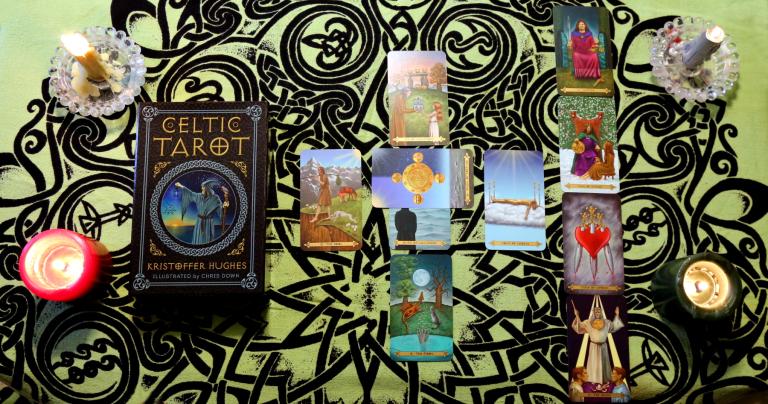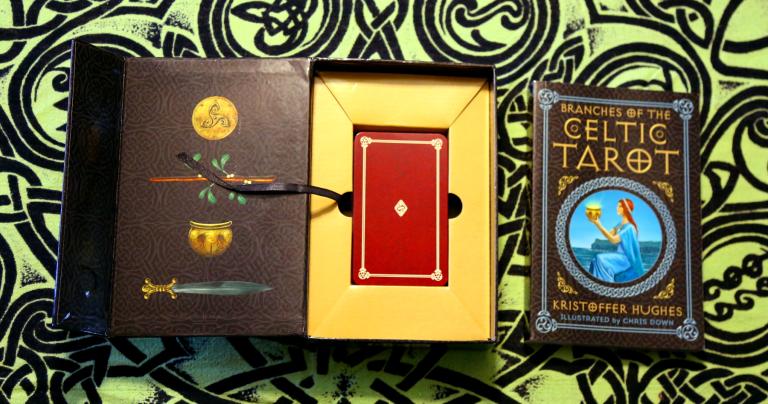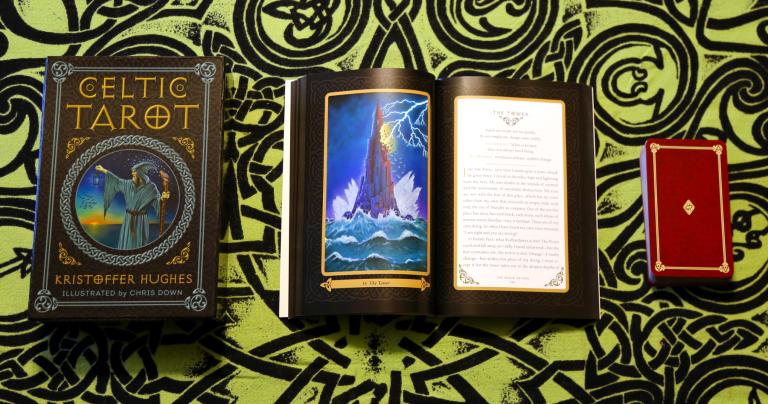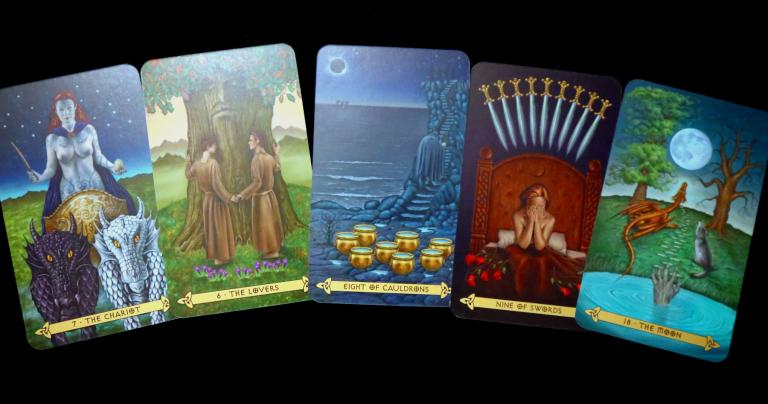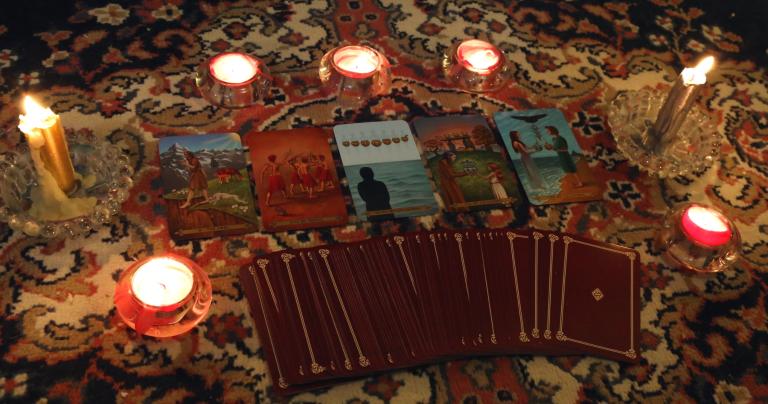A Tarot deck and accompanying book
by Kristoffer Hughes, illustrated by Chris Down
deck: 78 cards, book: 336 pages
published by Llewellyn – September 2017
$29.99
I don’t buy a lot of Tarot decks.
I came across The Robin Wood Tarot at the very beginning of my Pagan journey – it was one of the first magical tools I bought. It resonated with me and I’ve never had a reason to look for another. I have a Rider-Waite-Smith deck because some clients want a reading with the “traditional” cards. I have a couple of novelty decks I bought because I like the artwork, but I never read with them.
But when I heard Kristoffer Hughes was creating a Tarot deck I knew I’d have to have it. I love Kris’s books From the Cauldron Born (a book-length exploration of the story of Cerridwen and Taliesin) and The Journey Into Spirit (the best book on death and dying I’ve ever read from any religious perspective). I knew the deck would be good. I didn’t know if I could read with it or not.
So when Celtic Tarot arrived I did what you usually do with a new Tarot deck. I flipped through the cards looking at the artwork. I scanned the book, looking to see what’s there beyond a few generic interpretations (short answer: a lot). I liked what I saw.
And then, completely unplanned, I found myself shuffling the cards, cutting them, and laying them out in the familiar 10-card Celtic cross spread. I had no question in mind, I just wanted to see if the cards would speak to me.
Oh, did they ever speak to me!
Celtic Tarot is now my go-to deck for all my Tarot reading. I have a 24-year relationship with Robin Wood and that connection remains, but Celtic Tarot is simply louder and clearer. At least for me.
If you want my opinion, that’s it. If you want more details to help you figure out if it might speak to you, read on.
The Presentation
This is not a deck of cards with a Little White Book. It comes in a beautiful presentation box about the size of a DVD box set. Open it and you find the book: 336 glossy, full-color pages. Remove the book and you find the cards: the usual larger-than-playing-cards size (4-5/8” x 2-3/4”) with a simple back design and beautiful colorful artwork.
As I was taught, I keep my reading decks in a pouch, wrapped in white silk. I keep meaning to get a pouch and a piece of silk for Celtic Tarot, but this setup fits together so well I keep not doing it. Eventually I will – the box is too big to carry conveniently in my Tarot pack. But the presentation of the cards is very well done.
The Book
If you knew nothing about Tarot, could you read Branches of the Celtic Tarot and teach yourself to be a competent reader? Probably not, though as Kris says in the Introduction, learning isn’t nearly as complicated as some people make it out to be. But if you already know a thing or two about the Tarot, this book will do an excellent job of explaining what makes Celtic Tarot unique – the differences not just in artwork, but in the structure of the Journey of Wisdom.
The book gives a brief introduction to divination and to the history of the Tarot. It covers Celtic history and mythology – very briefly, to be sure, but enough to inform the reader and to give them an idea of where to go for more. It looks at the commonalities among the Court cards and the numbered cards of the Minor Arcana. It covers how to read for yourself and for others, and provides some basic spreads.
The majority of the book is devoted to the cards themselves. There is a full page picture of each card, three keywords for it, a description of the scene and what it means, and a listing of divinatory meanings for both upright and reversed (I don’t read reversed – my teacher said “if you need more than 78 images, you’ve got a serious problem”).
Reading the book’s entry on one card each day and committing it to memory would go a long way in helping you get really comfortable with them…
The Cards
The Tarot is part of the Western Mystery Tradition, which sees the world in four parts – the classic four elements and directions. Celtic culture proposes a three-part world. This makes creating a Celtic Tarot challenging. Kris keeps the four suits of the Minor Arcana, using shields instead of pentacles and cauldrons instead of cups. But he divides the Major Arcana into three sections: roots (cards 1 through 7), trunk (cards 8 through 14), and branches (cards 15 through 22). The Fool (card 0) stands alone, “neither the beginning nor the end of the journey through the mysteries of the Major Arcana, but in fact a figure that is representative of the journey in part or as a whole.”
The more commonly known Rider-Waite-Smith deck uses imagery that is explicitly Christian. Celtic Tarot is rooted in Welsh mythology, and thus there are some substitutions. The Mother and The Father replace The Empress and The Emperor, with similar meanings. The Druid replaces The Hierophant – the artwork is similar but the meaning is subtly but significantly different. The Merlin replaces The Hermit, Equilibrium replaces Temperance and The Shadow replaces The Devil. Rebirth replaces Judgement and looks nothing like it – it is a scene from the story of Cerridwen and Taliesin.
I jumped right in to reading Celtic Tarot, using my experience with other decks and letting the artwork speak to me. But while I’m familiar with Welsh mythology, I’m not an expert on it. If you don’t read the book, you may miss some of the symbolism.
The best example is the Nine of Cauldrons. In both Robin Wood and Rider-Waite-Smith, the Nine of Cups is a pleasant looking card signifying contentment and happiness. But Celtic Tarot’s picture of a dark hall with a sleeping man at one end of the table and a severed head on the other end gives a very different impression. Until, that is, you realize this is the head of Brân the Blessed, who has been speaking at the assembly. This is not some horror but the conclusion of a wonderful evening of fellowship.
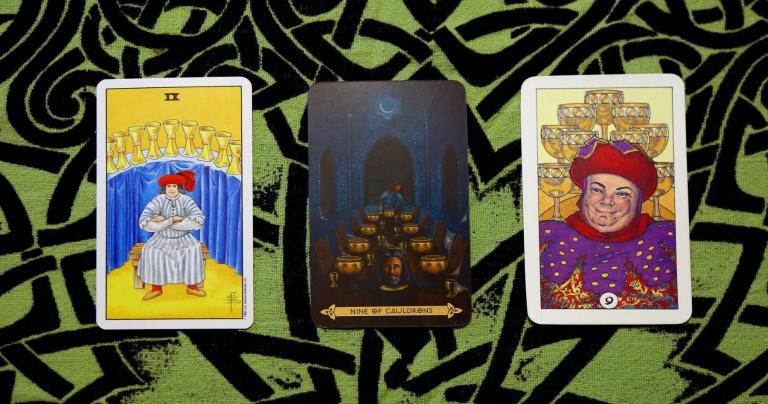
A Modern Pagan Tarot
Tarot is not an ancient wisdom tradition. It has its roots in tarocchi, an Italian card game from the 15th century. But it didn’t take long for people to began using tarocchi cards for divination.
The Rider-Waite-Smith deck is by far the most commonly used, but there are hundreds if not thousands of different decks, ranging from deeply spiritual to whimsical. Recent years have seen a resurgence of older decks such as the Tarot de Marseille and the Sola-Busca Tarocchi, the later published by Scarlet Imprint. At the other end of the spectrum, some cartomancers read with ordinary playing cards.
So why would a Celtic divination system be built on such a decidedly non-Celtic platform? Kristoffer Hughes answers that in the book:
The primary nature of this deck is based on the Rider-Waite-Smith system, and for good reason – this is the deck that I learnt from, and this is the deck that I, as the designer of the Celtic Tarot, am most familiar with. But more so than that, I also love the symbolism within the Rider-Waite-Smith system and the occult messages that swim within it.
Neither the Fool’s Journey nor the concepts of the Minor Arcana are Christian. They are universal spiritual concepts that have most commonly been expressed with Christian imagery. But they can also be expressed in Welsh imagery and in modern Pagan imagery.
Celtic Tarot does this. It gives those of us familiar with the Rider-Waite-Smith system a new set of tools for divination and meditation. It speaks universal wisdom in our language.
If I have any complaints with Celtic Tarot it’s with the physical cards. The cardstock is very flexible. That makes the cards easier to shuffle, but they don’t feel as substantial in my hand, even though a side-by-side comparison shows they’re as thick as other Tarot cards. Additionally, the glossy finish shows fingernail marks much more easily than the matte finish of some of my other decks. I’m concerned about their long-term durability.
But if they wear out I’ll probably just buy another deck. This deck is speaking to me unlike any other divination tool I’ve ever had.
For those who care about such things, I bought my copy of Celtic Tarot. Kristoffer Hughes is a dear friend and he wrote the foreword for my book The Path of Paganism. But my primary obligation in a review is to the reader, not the author. If the cards were no good I’d conveniently forget to review them.
The cards are very, very good.


